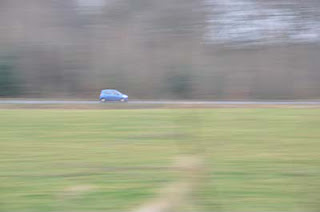I took a number of pictures of the old Foghorn at Fraserburgh for this exercise. I took the photographs very quickly placing the foghorn in multiple positions in the frame without thinking about the compositional impact. The following are my thoughts on the compositional results on each one:
Photograph 1 – Centre of the Frame
Can’t say much about this one other than it is a baseline image for the rest. The eye centres on the subject and doesn’t move.
Photograph 2 – Off Centre Right
I think this is quite a pleasing composition, the off centre position opens up more of the sea and gives a feeling of looking out to the ocean. The eye seems to start right and then left out to sea.
Photograph 3 – Far Right
This image has a similar effect to the previous but less pronounced, it feels a bit clumsy and at the far edge the subject almost seems less important. The wall leading out to the sea seems to attract the eye more.
Photograph 4 Off Centre Left
As with Photograph 2, this is quite a pleasing composition and the foreground grass is emphasised more. The eye travels through the foreground grass, to the foghorn and then out to sea.
Photograph 5 – Far Left
I find this composition unsettling because the eye seems to naturally want to go from right to left and out to sea following the foghorn but in this image there is nowhere for it to go!
Photograph 6 – Off Centre Up
This composition doesn’t feel much different to the baseline image but the foreground grass is slightly more emphasised which leads the eye into the picture a bit more.
Photograph 7 – Far Up
This image leads the eye in the same way as photograph 6. Although it does feel like the foghorn is at the top of a pyramid.
Photograph 8 – Off Centre Down
Although the foghorn is centred I find this a nice composition, in this position the sky is emphasised which gives a placid feeling in this case.
Photograph 9 - Far Down
I find this composition clumsy looking, the wall has been cut off, there is too much plain sky and it feels accidental.
Photograph 10 – Off Centre Left and Down
This composition is also quite pleasing, the curve of the wall leads down quite nicely to the foghorn.
Photograph 11 Far Left and Down.
Surprisingly, I find this composition ok although I expected this subject positioning not to produce a good image. I think it has a similar effect to Photograph 10.
Photograph 12 - Off Centre Right and Down.
I like this composition but find the effect similar to photograph 2
Photograph 13 – Far Right and Down
As with photograph 11, I was surprised to like this composition. The positioning of the subject allows an expanse of sea and sky to be shown, more so than the other images. This gives a nice feeling of isolation emphasising the vastness of the ocean.
Photograph 14 – Off Centre Right and Up
In this image, the grass in the foreground comes into play a lot more as a compositional element providing depth and a balance to the foghorn.
Photograph 15 - Far Right and Up
The effect in this image is similar to photograph 14 but looks a bit more clumsy and is less effective. The distortion and blur of the lens at its extremities is also noticeable here.
Photograph 16 – Off Centre Left and Up
The effect in this image is similar to photograph 4
Photograph 17 – Far Left and Up
This image emphasises the grass far too much and the image has now become about the foreground grass with the foghorn as a background element.
Key Learning points from this exercise:
Arranging the subject positions in a matrix where succesful compositions are green and unsuccesful red (in my opinion) shows:
It's clear that there is a sweet zone around the off centre positions but it surprised me that the bottom three also all provided succesful compositions going against the often quoted rule of thirds. This shows to me that there are no hard and fast rules when it comes to composition and what works is subjective. However placing subjects carelessly is not the answer, placement in the frame has a different effect and emphasises different things in the scene. So composition is about subject placement and understanding the effects of placement rather than being too hung up on rules.
A more practical point is that lenses are generally not at their best at the extermities of the image, so if the main subject is there then any lens imperfections will be more noticeable.




































